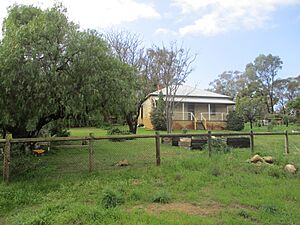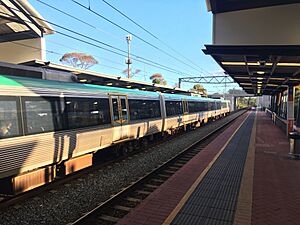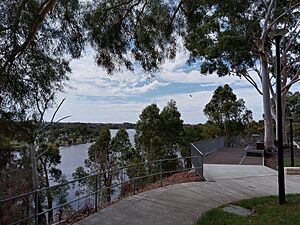Leda, Western Australia facts for kids
Quick facts for kids LedaPerth, Western Australia |
|||||||||||||||
|---|---|---|---|---|---|---|---|---|---|---|---|---|---|---|---|

Leda, seen from Kwinana Lookout
|
|||||||||||||||
| Established | 1969 | ||||||||||||||
| Postcode(s) | 6170 | ||||||||||||||
| Area | 8.8 km2 (3.4 sq mi) | ||||||||||||||
| LGA(s) | City of Kwinana | ||||||||||||||
| State electorate(s) | Kwinana | ||||||||||||||
| Federal Division(s) | Brand | ||||||||||||||
|
|||||||||||||||
Leda is a suburb located south of Perth, Western Australia. It is part of the City of Kwinana and is one of its five main suburbs.
Leda was named after a ship called the Leda. This ship brought early settlers to the Swan River Colony in January 1830. The name for the suburb was officially approved in 1969. Leda is closely connected to its nearby suburb, Wellard, sharing transport and shopping options.
The weather in Leda is typical for Western Australia. Most of the rain falls during the cooler months, from May to September. Many people living in Leda work in Kwinana's industrial area. Common jobs are in construction, planning, and technical fields. Working in shops or preparing food are also popular jobs. Leda and its nearby suburbs have several schools, including some that help young people with disabilities.
Leda also has a special area protected for its environment. This reserve includes wetlands and forests. It is part of the Swan Coastal Plain and the Beeliar Wetlands system. The Swan River helps collect water for the area.
Contents
Exploring Leda's Geography
Leda is about 5.6 kilometres from the coast of Western Australia. It is also about 41.3 kilometres from the capital city, Perth. The suburb sits 23 metres above sea level.
Most of Leda, about 90%, is used for homes. The area also has a lot of native bushland, especially Sclerophyll forest. This covers about 959.8 hectares of land.
Leda's Climate and Water
The water that flows over the land in Leda goes into the Swan River and the Murray River. Leda's weather is affected by the Indian Ocean. More rain falls when westerly winds increase across the equator. This creates a temperature difference in the Indian Ocean. It causes warmer water to build up on Australia's west coast. This change is called a negative Indian Ocean Dipole.
The climate in Leda is mostly dry. It has rainy winters and hot, dry summers. This is known as a Mediterranean climate. July and August are the coldest months. Because Leda is near the coast, it gets cool breezes in summer. These are often called the "Fremantle doctor." The average low temperature from 2001 to 2021 was 15.5 degrees Celsius. The average high temperature was 27.9 degrees Celsius.
Who Lives in Leda?
The average age of people in Leda is 30 years old. About 27.2% of the population are children aged 0–14. People over 65 make up 6.4% of residents.
In 2016, about 35.4% of Leda's population were attending school or college. The average household income per week was 1411 Australian dollars. Of the 1516 people working, 52.2% worked full-time. About 29.6% worked part-time, and 13.3% were looking for a job.
Many people in Leda work as technicians (18.8%). Others work in construction (15%). Some are machinery operators or drivers (13.2%). About 12.9% work in retail.
Leda's Background and Languages
The most common backgrounds in Leda are English (28.8%) and Australian (25.8%). Other backgrounds include Scottish (6.0%) and Irish (4.7%). Some residents are from New Zealand (7.4%), with 3.3% having Māori family. People from the Philippines make up 3.5%, South Africa 1.4%, and India 1.3%.
Most residents (62.3%) were born in Australia. About 77.8% speak only English at home. Only 19.4% of homes speak a language other than English. Christianity is the main religion (54%). This includes Anglican, Catholic, and Protestant faiths. About 36% of people said they had no religion.
Non-English languages spoken include Tagalog (1.8%), Māori (0.8%), Afrikaans (0.6%), Indonesian (0.5%), and Filipino (0.8%).
Leda's Past
The name Leda comes from an old Greek story called Leda and the Swan. The name was approved on March 18, 1969. It also refers to the colonial ship 'Leda'. This ship brought settlers to the Swan River in Western Australia in January 1830.
Leda was created in the 1950s. It was part of the City of Kwinana. The suburb was built to provide homes for people working at the oil refineries in Kwinana. This was part of an agreement with BP Oil Refinery.
Before 1953, the area was mostly used for farming. Two important historical sites are Mead Farm and Sloan's Cottage. Henry Mead bought Mead Farm in 1854. He used it for crops and animals until 1984.
Sloan's Cottage was built in 1911 by George and Emma Eliza Sloan. They grew commercial crops like potatoes and cabbages. These were sold at the Fremantle Markets. The farm remained active until 1953-1954. Then, the land was given to Kwinana council for building homes.
After farming stopped, the cottage was used by different owners. When Leda was being developed, the cottage became empty and was damaged. It was even planned for demolition. But from 1973 to 1978, the building was rebuilt. This happened with a government grant for historical preservation. Wally Procter, the deputy Mayor of Kwinana, suggested it. The cottage was listed as a heritage site in 1992.
The area around Sloan's Cottage is now part of the Leda Nature Reserve. In 1994, this land was recognized for its rich variety of plants and animals. It was then used for conservation. Since 1992, the gardens have been used for Permaculture. This helps improve soil quality and grow native plants.
Learning in Leda
Leda has its own main public school, Leda primary school. It is for both boys and girls. Other primary schools in Kwinana, like Orelia, Cooloongup, Wellard, and Bertram, also serve Leda.
The Leda Education Support Centre is a special primary school. It opened in 1992. This school helps children with Autism, Global developmental delay, and other learning difficulties. They use special teaching methods to help students learn skills. These include reading, writing, math, and personal care. They also teach life skills like shopping, gardening, and hygiene.
Popular high schools in the Kwinana area include Peter Carnley Anglican Community School, Gilmore College, and The King's College of Western Australia.
Jobs and Shopping
Many people in Leda work in Kwinana's industries. This includes companies like BP Oil Refinery and BHP Iron and Steel. About 47% of Leda's workers are in construction, planning, or technical jobs.
About 4.4% of Leda's workers are in retail, like supermarkets. Another 3.5% work in takeaway food services. Leda also plays a role in farming. Companies like Manna Soils use industrial waste to help soil and plants grow.
The main shopping centre in Leda is Stargate Shopping Centre. It covers 2800 square metres. The Kwinana Marketplace is another big shopping area. It is near Wellard railway station. Both places have major supermarkets like Coles Supermarkets, Aldi, and IGA (supermarkets).
Leda has a lower socioeconomic score compared to the Australian average. This means it has some disadvantages.
Getting Around Leda
Train connections between Perth and its suburbs have been improved. This makes travel easier and helps reduce car use. New train lines were built from 2001 to 2006.
The closest train station to Leda is Wellard station. It is 2.6 kilometres away and is on the Mandurah line. From Wellard, you can go towards Rockingham or towards Perth. The train line runs along the Kwinana Freeway. This allows direct travel to and from Perth city.
Buses are available from Rockingham Road and Gilmore Avenue. The transport system was designed to make travel easy in busy areas like Wellard and Rockingham.
Kwinana council has said that buses cover busy areas well. However, they are not very frequent. They also do not cover industrial work areas well. New homes are being built faster than bus services are growing. This can lead to more traffic. A study found that train stations are not always close enough to homes and workplaces. However, train travel takes about the same time as driving to major centres. This encourages people to use trains more.
Bus Routes
- 541 from Wellard Station to Kwinana Station – serves Doniford Way, Dalrymple Drive and Gilmore Avenue
- 549 from Rockingham Station to Fremantle Station – serves Gilmore Avenue
Leda's Environment and Growth
Leda is a residential area within Kwinana's city centre. Other suburbs like Wellard, Medina, Orelia, Parmelia, and Calista are also part of this area. Leda gets its drinking water from the Perth Seawater Desalination Plant. It also uses groundwater from near Kwinana.
The groundwater in Leda is about 16 metres below the surface. It naturally has a high salt content. So, this groundwater is mainly used for watering salt-resistant plants. Or, it needs to be treated to remove salt. The soil in Leda is good for farming. It can grow plants for animal feed and essential oils.
Leda's wastewater is collected at the Dalrymple Drive pump station. This pump station was expanded in 2017. Leda also has a community centre, a neighbourhood park, and a local sports ground. Sporting facilities like tennis courts and playing fields are also in nearby Kwinana suburbs. The local library for Leda is the Darius Wells Community Knowledge and Resource Centre.
The natural areas in Leda's nature reserve have different types of sand dunes. These are called Bassendean, Spearwood, and Quindalup dunes. They are an important part of the Swan Coastal Plain in Western Australia. The ground is mostly made of Calcarenite Tamala limestone.
Conservation sites in Leda protect low woodlands and open forests. Common trees include the tuart (Eucalyptus gomphocephala), jarrah (Eucalyptus marginata), and different Banksia species. The tuart tree is a protected plant in the region. Seasonal wetlands also have swamp paperbark (Melaleuca rhaphiophylla) and coastal saw-edge (Gahnia trifida).
About 70% of the native plants in 1996 were in very good condition. However, some areas have been damaged by chemicals, farming, and land clearing.
Leda Nature Reserve
Leda Nature Reserve is a place for recreation and conservation. It is about 438 hectares in size. It has forests and wetlands that provide homes for waterbirds. These include the Australian wood duck, Grey teal, White-faced heron, and Nankeen night heron.
The Nature Reserve is part of the Swan Coastal Plain South Management Plan. It helps protect native animals like the Southern brown bandicoot, Western brush wallaby, and Australian Echidna. It also follows international agreements for conservation. These include agreements for migratory animals and wetlands, like the Ramsar Convention.
The Beeliar Wetlands system is also protected. This helps manage invasive plants, monitor plant growth, and process industrial waste.
Images for kids








